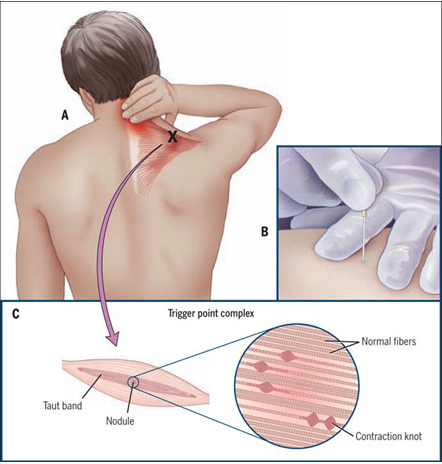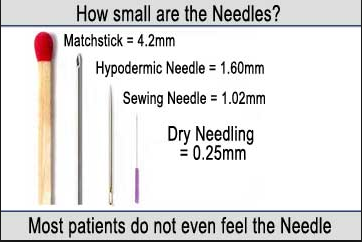Dry Needling
"Dry Needling is a skilled intervention that uses a thin filiform needle to penetrate the skin and stimulate underlying myofascial trigger points, muscular, and connective tissues for the management of neuromusculoskeletal pain and movement impairments. Dry needling (DN) is a technique used to treat dysfunctions in skeletal muscle, fascia, and connective tissue, and, diminish persistent peripheral nociceptive (pain) input, and reduce or restore impairments of body structure and function leading to improved activity and participation."
American Physical Therapy Assoc. 2013

So, in English, what does that mean? If you suffer from painful muscle spasms, you may have heard of the term "dry needling". Dry needling is relatively new in the therapy world and is quickly growing in popularity especially in the sports medicine world. Dry Needling can ease tight muscles, decrease joint pain, increase blood flow and increase endorphins, which serve as the body's natural pain killers. In a time when opioid addiction is worse than ever, dry needling can be a great natural way to provide relief of pain.

Why do they call it "dry needling"? The term dry needling refers to the fact that the needles themselves do not contain any medication. When the concept of using a needle to treat a trigger point first started, doctors would often inject a solution of saline and lidocaine into the muscle. As time progressed, it was discovered that it wasn't really the medication being injected into the muscle that was so effective, but rather the needle injection itself. Later still, it was discovered that the use of a tiny acupuncture needle was much more comfortable for the patient and just as effective.
The primary goal of dry needling is to desensitize the irritable, tender knots in muscle tissue that cause pain. Dry needling can also improve "referral pain" or pain in which you can press on a certain muscle or knot and feel the pain in a different area of the body. Dry needling has been shown to be effective in treating the deep muscle layers and soft tissues that can't be reached by other kinds of therapy.
Isn't this just another name for Acupuncture? The answer is 100% NO! While both techniques involve the use of needles, they are used for different purposes. Just because I drive a car doesn't make me a NASCAR driver! Get the point? Acupuncture is a wonderful technique that is based on the idea that there is a path of energy flow throughout the body that can become disrupted and cause disease. Acupuncture needles are inserted along this energy pathway or meridian as they are known.
Dry Needling, on the other hand, treats musculoskeletal pain and the needles are inserted into the tight muscle bands of the affected area. Therefore, it is targeted directly around the anatomy of the body and the location of your symptoms. Dry needling is a very evidence-based practice and treatment.
What is the Science behind Dry Needling? When an injury occurs, inflammation is produced in the damaged tissue. It also tenses up as a protective response against further damage. Together, the inflammation and tension slow the amount of oxygen-rich blood that reaches the injury site. Cells in this area then produce scar tissue, which starts to build up around the muscles limiting its functionality and irritating the nerves.
Dry needling can re-initiate the healing process to correct the areas of scar tissue and muscle tightness and improve efficiency and function of the surrounding tissue. It also functions to signal the body's immune system and restart a healing process that may have not been completed in a previous injury. This can break the pain cycle by reducing inflammation, decreasing muscle tightness and improving flexibility.
What Conditions Benefit from Dry Needling?
The following is a common list, but should not be considered the only conditions treated:
- Neck and Back pain
- Shoulder pain
- Elbow pain
- Headaches
- Herniated and/or degenerative disc pain
- Hip and Gluteal pain
- Knee, Ankle and Foot pain
- Plantar Fascitis
- Sciatica
- Pelvic pain
- Jaw or TMJ pain
- Repetitive motion disorders (like carpal tunnel syndrome)
Does it Hurt?
Because the needles are so small, you may or may not feel the insertion of the needle. The specific needle manipulation is intended to produce a local twitch response that can elicit a very brief (often less than a second) painful response that some patients describe as a deep ache or cramping sensation. The therapeutic response occurs with the elicitation of the local twitch response and is the desired reaction.
How many treatments does it take and what can I expect after treatment?
We are looking to get improvements even from the very first visit such as increased range of motion, ease of movements and decreased pain or signs/symptoms. While there may be some patients who are better in one or two visits, others with more chronic conditions may take longer or require maintenance care.
Following a treatment, many patients report being sore in both the area that was treated as well as the area of referred symptoms. Typically this soreness lasts between an hour to a couple of days. The use of ice or heat as well as light massage and/or stretching may alleviate the soreness. There may also be feelings of fatigue following a treatment. Finally, there is a possibility of slight bleeding at the place where the needle was inserted as well as some light bruising.
What does it cost and does my insurance cover it?
At the current time, insurance companies have specifically stated that they do not cover this service. While that may change someday, at the current time, billing any insurance company for dry needling would constitute insurance fraud. Therefore, our current fee for this service is $50 a visit for an existing patient. New patients are required to go through an exam and consultation before any treatment is rendered. Due to the nature of this treatment, we have very specific times when this treatment is performed. Please be sure to speak to the front desk to specifically schedule a dry needling visit. A dry needling visit will last approximately one half hour depending on the number of sites being treated. Please note that it is impossible to treat multiple body regions in one session. Separate visits for different regions would be required. If you have multiple areas of complaint we will start treatment on the area that bothers you the most.